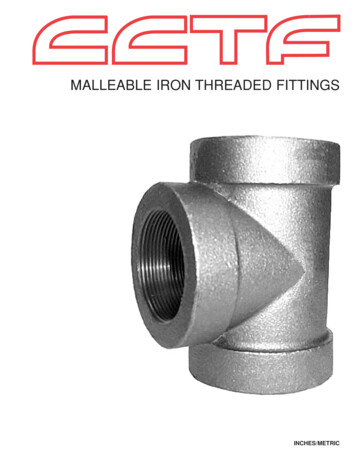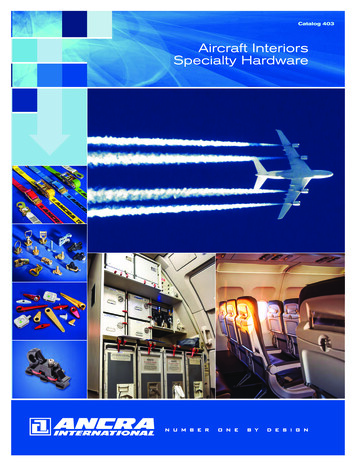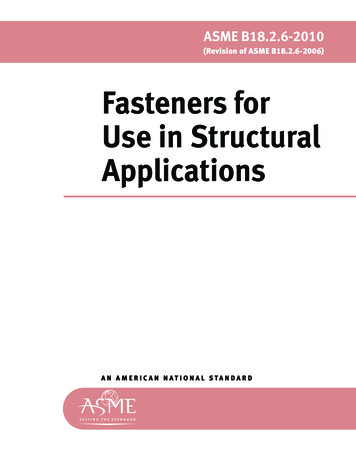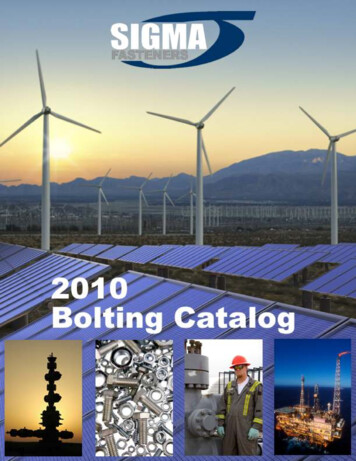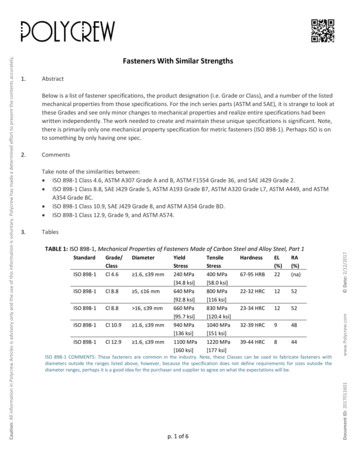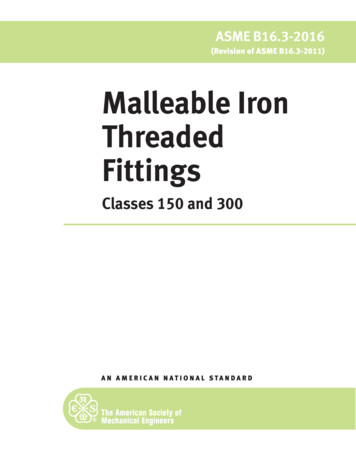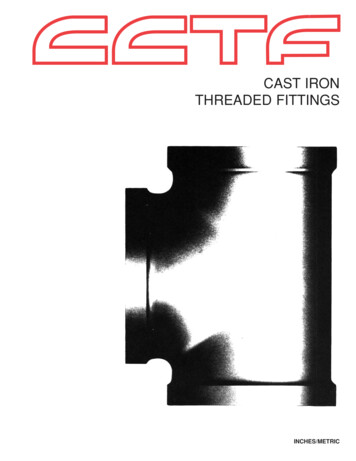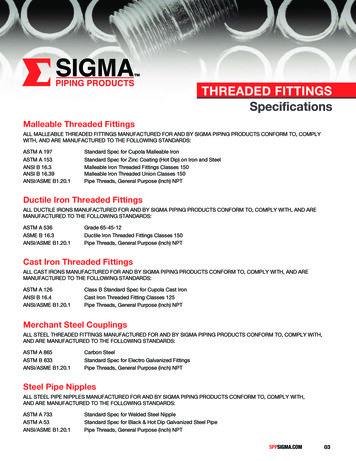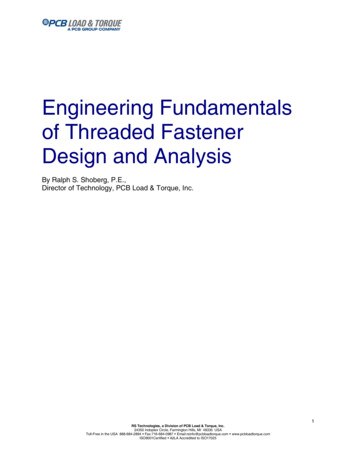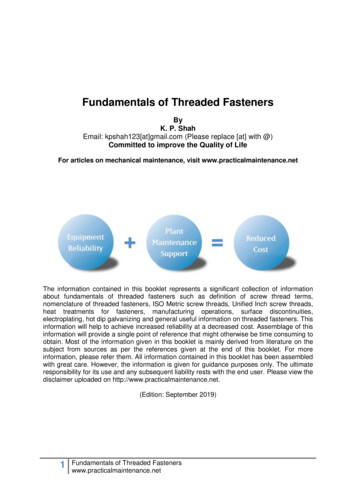
Transcription
Fundamentals of Threaded FastenersByK. P. ShahEmail: kpshah123[at]gmail.com (Please replace [at] with @)Committed to improve the Quality of LifeFor articles on mechanical maintenance, visit www.practicalmaintenance.netThe information contained in this booklet represents a significant collection of informationabout fundamentals of threaded fasteners such as definition of screw thread terms,nomenclature of threaded fasteners, ISO Metric screw threads, Unified Inch screw threads,heat treatments for fasteners, manufacturing operations, surface discontinuities,electroplating, hot dip galvanizing and general useful information on threaded fasteners. Thisinformation will help to achieve increased reliability at a decreased cost. Assemblage of thisinformation will provide a single point of reference that might otherwise be time consuming toobtain. Most of the information given in this booklet is mainly derived from literature on thesubject from sources as per the references given at the end of this booklet. For moreinformation, please refer them. All information contained in this booklet has been assembledwith great care. However, the information is given for guidance purposes only. The ultimateresponsibility for its use and any subsequent liability rests with the end user. Please view thedisclaimer uploaded on http://www.practicalmaintenance.net.(Edition: September 2019)1Fundamentals of Threaded Fastenerswww.practicalmaintenance.net
ContentChapter12345-TitleIntroductionScrew ThreadsManufacturing of Threaded FastenersPlating and CoatingsGeneral Information on Threaded FastenersReferencesPage No.31235455764For more information on threaded fasteners, please visit www.practicalmaintenance.net2Fundamentals of Threaded Fastenerswww.practicalmaintenance.net
IntroductionA fastener is a device that holds two or more objects together. A fastener can be a bolt andnut, a screw, a rivet, or even a staple. However, the majority of fasteners used in industryare threaded fasteners. They are used to join individual elements in a secure and cheap waythat can be assembled and disassembled as often as required. Information about definitionof screw thread terms, nomenclature of threaded fasteners and fastener categories (bolts,screws and studs) is given in this chapter.Definition of Screw Thread TermsAbove figure shows screw thread terms (thread nomenclature).Screw ThreadA screw thread is a continuous projecting helical ridge usually of uniform section either onthe external or internal surface of a cylindrical or conical surface. Internal threads refer tothose on nuts and tapped holes, while external threads are those on bolts, studs, or screws.Thread FormThe thread form is the shape or profile of the thread in an axial plane for a length of onepitch of the thread; composed of the crest, root, and flanks. At the top of the threads are thecrests, at the bottom the roots, and joining them are the flanks. Thread forms include vee (V)threads, square threads, etc.Threaded screws are used for two purposes: fastening and power transmission. The threadprofile used for fasteners is V (flanks make an acute angle at thread tip) while the powerscrews have threads with flanks parallel or near parallel. For power transmission it isessential that frictional torque must be less and it is achieved with Square, Acme or Buttressthreads.AxisThe axis of the thread pitch cylinder or cone is called axis of the thread.3Fundamentals of Threaded Fastenerswww.practicalmaintenance.net
CrestCrest is the surface of a thread that joins the flanks of the same thread, and is farthest fromthe cylinder or cone from which the thread projects.RootRoot is that surface of the thread that joins the flanks of the adjacent thread forms and isimmediately adjacent to the cylinder or cones from which the thread projects.FlankFlank is the part of a helical thread surface that connects the crest and the root, which istheoretically a straight line in an axial plane section.PitchThe pitch, P, of a thread having uniform spacing is the distance, measured parallel to itsaxis, between corresponding points on adjacent thread forms in the same axial plane and onthe same side of the axis. Pitch is equal to the lead divided by the number of thread starts.Pitch DiameterPitch diameter is the diameter of an imaginary cylinder or cone, the surface of which wouldpass through the thread profiles at such points as to make the width of the thread groove orthread vee (measured parallel to the axis) equal to half of the pitch.The line which generates the imaginary pitch cylinder or cone is called pitch line.Major DiameterOn a straight thread, the major diameter is that of the major cylinder, an imaginary cylinderthat would bound the crest of an external straight thread or the root of an internal straightthread.Nominal size is the designated size which is used for the purpose of general identification.The major diameter of a threaded fastener is often referred to as ‘nominal size’ or ‘nominaldiameter’.Minor DiameterOn a straight thread, the minor diameter is that of the minor cylinder, an imaginary cylinderthat would bound the root of an external straight thread or the crest of an internal straightthread.Height of ThreadThe height (or depth) of a thread is the radial distance, measured perpendicular to the threadaxis, between the major and minor cylinders or cones respectively.Thread AngleThread angle is the included angle formed by two adjacent flanks in an axial plane.4Fundamentals of Threaded Fastenerswww.practicalmaintenance.net
HelixA helix is the curve generated/defined by moving a point with uniform angular and linearvelocity around an axis. Hence, a helix is the curve on a cylindrical or conical surface, whichintersects all planes perpendicular to the axis, at a constant oblique angle.Lead of HelixLead of helix is the axial distance between two consecutive points of intersection of a helixby a line parallel to the axis of the cylinder on which it lies, i.e., the axial movement of athreaded part rotated one turn in its mating thread.Helix Angle and Lead AngleAs shown in above figure, if one turn of a helical curve is unrolled onto a plane surface, thehelix would become a straight line forming the hypotenuse of a right angle triangle. Thelength of one side of this triangle would equal the circumference of the cylinder with whichthe helix coincides, and the length of the other side of the triangle would equal the lead ofthe helix.The triangular development of a helix has one angle A subtended by the circumference ofthe cylinder, and another angle B subtended by the lead of the helix. The term “helix angle”applies to angle A. Angle B is called the “lead angle” because it is subtended by the lead ofthe thread. Angle B, applied to screw threads and worm threads is referred to as the leadangle of the screw thread or worm. This angle B is a measure of the inclination of a screwthread from a plane that is perpendicular to the screw thread axis. The helix angle is thecomplement to the lead angle. It may be noted that for threaded fasteners, many times thehelix angle is referred as shown in the figure titled screw thread terms on page number 3 ofthis booklet.Single-start Thread and Multiple Start ThreadStart is used to indicate the number of individual threads on a device. As shown in thefollowing figure, a device with a single-start thread has one thread having the lead (L) equalto the pitch (P). A multiple start thread is a screw thread with two or more threads where thepitch is equal to the thread lead divided by the number of thread starts. A multiple startthread is also called multiple lead thread. Hence, on a single lead thread, the lead is equal tothe pitch. On a double lead thread (double start), the lead is equal to twice the pitch and soon.5Fundamentals of Threaded Fastenerswww.practicalmaintenance.net
Incomplete ThreadIncomplete thread is a thread profile having either crests or roots, or both, whose profiles lieoutside the size limits, resulting from the intersection with the cylinder or end surface of thework or vanish cone. It may occur at either end of the thread.Vanish cone is the conical surface bounding the roots of the vanish thread formed by thechamfer of the cutting tool or by the tool withdrawal pattern. Vanish thread is that portion ofthe incomplete thread that is not fully formed at the root or at crest and root. It is produced bythe chamfer at the starting end of the thread forming tool. Vanish thread is also known aspartial thread, washout thread, or thread runout.Incomplete lead thread is the incomplete thread at the starting end of a screw thread.Incomplete runout thread is the incomplete thread at the terminating end of a screw thread.Right-hand and Left-hand ThreadsRight-hand thread (RH) is a screw thread that advances the screw forward (screws in) onclockwise rotation. Left-hand thread is a screw thread that advances the screw forward oncounterclockwise rotation. All left-hand threads are designated by the symbol (LH).6Fundamentals of Threaded Fastenerswww.practicalmaintenance.net
All threads are usually right-handed unless otherwise is indicated. Left-handed threads areoften used in situations where rotation loads would cause right-hand threads to loosenduring service. A common example is the bicycle. The pedals of a bicycle are attached to thecrank arm using screw threads. The pedal on one side of the bicycle uses right-hand threadand the other uses left-hand. This prevents the motion of pedals and crank from unscrewingthe pedal and having it fall off during use.Left Handed threads are used extensively in the Motor Industry and rotating equipment (e.g.pumps) to secure rotating parts such that the normal angular rotation would tend to tightenthe nut. When working on rotating parts, always check the hand of the thread or refer theinstruction manual.Nomenclature of Threaded FastenersA threaded fastener (for example, bolt/screw) is a fastener, a portion of which has some formof screw thread. A bolt/screw is made up of the shank and the head. The shank is threaded,either for part of its length or for the full length from the end to the head. Longer bolts areusually only partly threaded. There is no need to make a thread longer than is necessary totighten the joint as this will only make the bolt more expensive. The following figure showsnomenclature of threaded fasteners.Nominal Size / Nominal DiameterNominal size is the designated size which is used for the purpose of general identification.The basic major diameter of a threaded fastener is often referred to as ‘nominal size’ or‘nominal diameter’. It may be noted that actual (measured) major diameter is smaller thanthe basic major diameter due to deviation/allowance and manufacturing tolerance.HeadHead is the enlarged shape that is formed on one end of the headed fastener (a fastenerhaving one end enlarged or preformed) to provide a bearing surface and a method of turning(or holding) the fastener.7Fundamentals of Threaded Fastenerswww.practicalmaintenance.net
Bearing SurfaceBearing surface is the supporting or locating surface of a fastener with respect to the part itfastens. The loading of a fastener is usually through the bearing surface.Length or Nominal LengthThe length of a headed fastener is the distance measured parallel to the axis of the product(bolt, screw, etc.) from the largest diameter of the head with the bearing surface to theextreme end of the product, including point if the product is pointed. For example, square orhex head bolts are measured from under the head to the end of the bolt; a bolt with acountersunk head (head, the underside of which is beveled to fit a flaring hole) is measuredoverall. The point of a bolt is always included in the measured length.Headless fasteners such as studs are measured overall, including points, except forcontinuous threaded alloy studs made to ASTM Specification A193. This type is measuredfrom first thread to first thread (length does not include points).Thread LengthThread length is the length from the extreme point of the bolt or screw to the last complete(full form) thread.Grip Length / Grip Gaging LengthGrip length (body) is the distance measured parallel to the axis of the bolt or screw from theunder-head bearing surface to the face of a non-counterbored, non-countersunk standardGO thread ring gage (to visualize, nut) assembled by hand as far as the thread will permit.Simply stated, it is the length of unthreaded portion of the shank.ShankShank is that portion of a headed fastener which lies between the head and the extremepoint (starting thread).PointThe point of a fastener is the configuration of the end of the shank of a headed fastener or ofeach end of a headless fastener. Unless otherwise specified, bolt or screw need not bepointed. The presence of a point is to reduce the possibility of damage to the leading threadsand promote assembleability with a tapped hole or nut.Chamfer and Chamfer AngleChamfer is the beveled edge (conical surface) at the starting end of a thread. The chamferangle is the angle of the chamfer measured from the normal to the axis of the fastener and isgenerally specified in conjunction with either a length or a diameter.8Fundamentals of Threaded Fastenerswww.practicalmaintenance.net
Bolts, Screws and StudsThreaded fasteners are usually grouped into three main categories: bolts, screws and studs.Above figure shows the methods of making joints using them.BoltsA bolt is the term used for a threaded fastener with a head on one end of a shank or bodyand a thread on the other end. Designed for insertion through holes in assembly parts, it ismated with a tapped nut. Tension is normally induced (or released) in the bolt to compressthe assembly by rotating the nut. This may also be done by rotation of the bolt head. Boltsrequire two tools to tighten or loosen them.A nut is an internally threaded product intended for use on external or male screw threadssuch as a bolt or stud for the purpose of tightening or assembling two or more components.ScrewsScrew is a headed threaded fastener that is designed to be used in conjunction with a preformed internal thread or alternatively forming its own thread (Historically, it was a threadedfastener with the thread running up to the head of the fastener that has no plain shank.However, this definition has largely been superseded to avoid confusion over the differencebetween a bolt and a screw.). Tension is induced in it by rotation of the head. As a screw ismated into an internal (female) thread in a work piece, it only requiring one tool to tighten orloosen it. Screws are sometimes divided into two sub-categories; cap screws and machinescrews. Machine screws are generally smaller in size than cap screws and they are used forscrewing into thin materials.StudsA stud is a fastener which is threaded at both ends with an unthreaded shank in between.One end (which often has a thread tolerance which results in more thread interference) issecured into a tapped hole, the other is used with a nut to create tension. Studs are a hybridbetween a bolt and a screw, since one end of the stud functions as a screw while the otherfunctions as a bolt. As shown in above diagram, it is usual for the stud to be screwed into thethreaded hole to the end of the thread on the stud.In case of a stud joint, the upper part has a clearance hole and the lower part has a tapped(threaded) hole. Stud joints have some advantages compared with other fastening methods.The projecting studs can be used to locate and guide parts during assembly. The tappedhole takes up little space and the hole can be BLIND (i.e. not all the way through thecomponent) which may avoid sealing problems. Studs are generally intended to be screwedas far as possible into the tapped hole in a component (i.e. right to the end of the threaded9 Fundamentals of Threaded Fastenerswww.practicalmaintenance.net
section of the stud, not the end of the threaded section of the hole) and to remain there as asemi-permanent attachment. The joint is detached by unscrewing the nut from the exposedend of the stud. Wear and tear of the tapped hole is thereby avoided.As shown in above figure, if a stud is threaded for its entire shank length and a nut used onboth ends to create tension, it serves the function of a bolt and is then called/classified as aStud Bolt.The terms bolt and screw are sometimes used interchangeably and they can refer to thesame element. In practice, the basic difference between a bolt and a screw is that a bolt isusually intended to be used in conjunction with a nut where it will be tightened or loosenedusing the nut, while a screw is usually intended to be mated with an internally threaded holeand the screw head is used for tightening or loosening.Appendix B of ASME B18.2.1-1996 has established a recommended procedure fordetermining the identity of an externally threaded fastener as a bolt or as a screw. As per therecommended procedure:A bolt is an externally threaded fastener designed for insertion through holes in assembledparts, and is normally intended to be tightened or released by torquing a nut.A screw is an externally threaded fastener capable of being inserted into holes in assembledparts, of mating with a preformed internal thread or forming its own thread, and of beingtightened or released by torquing the head.For more information on the recommended procedure, please see ASME B18.2.1-1996.10Fundamentals of Threaded Fastenerswww.practicalmaintenance.net
Above figure shows details of some commonly used joint configurations for threadedfasteners and the holes machined (see top section of above figure) in the upper componentsprior to fitting the screwed fasteners. The figure also shows ways in which the joint can bemade flush at the head of the fastener using socket (allen) head cap screw in thecounterbore and countersunk (flat) head cap screw in the countersink.A hole enlarge to a given depth is called counterbore. Counterboring is the process ofenlarging for part of its depth a hole previously formed and to provide a shoulder at thebottom of the enlarged hole. Special tools called counterbores are generally used for thisoperation.Holes in which countersunk head type fasteners are to be used must be countersunk toprovide a mating bearing surface. Countersinking is the process of beveling or flaring theend of a hole. A countersink is a bevel or flare (internal chamfer) at the end of a hole.It can be seen that in case of a joint made using a bolt and nut, the bolt passes throughclearance holes in the parts to be joined whereas in case of a joint made using a screw, theupper part has a clearance hole and the lower part has a tapped (threaded) hole.It may be note that in case of a joint made using a bolt and nut both the bolt head and thenut project from the surfaces of the components. This may be a serious disadvantage insome applications (e.g. where space is restricted or the assembly is rotating and theprotruding heads could be a catch point) and can be avoided by a different choice offastener.An alternative to avoid the projecting nut is to replace the threaded nut with a suitably sizedinternal helix (i.e. a thread similar to that in a nut) machined into one of the components tobe fastened (as shown in above figure). The process of forming the internal thread in thisway is called Tapping and the hole is then called a Tapped Hole.The major disadvantages of using the internal threads are: If the thread gets damaged, the part may have to be scrapped, or repaired (one of themethod is to use “Helicoil” insert, if possible). Threads tapped into materials such as aluminium or cast iron are weaker than thethreads on a steel nut. It is costlier to cut (i.e. tap) a thread in the component rather than buy the thread readymade in a nut.A washer is a part usually thin, having a centrally located hole. The washer performs variousfunctions when assembled between the bearing surface of a fastener and the part beingattached. Insulation, lubrication, spanning of large clearance holes, and improved stressdistribution are a few design uses.A washer face is a circular boss on the bearing surface of a bolt or nut.SEMSSEMS is a preassembled (preasSEMbled) screw and washer unit in which the washer isretained free to rotate under the screw head by the rolled thread. The major diameter of thescrew being larger than the washer hole, it prevents the washer from coming off. These unitsexpedite assembly operations and assure the presence of a washer in each assembly. Theyare generally available in various combinations of head styles and washer types.11Fundamentals of Threaded Fastenerswww.practicalmaintenance.net
Screw ThreadsThreads were developed in many parts of the world, and as such produced a bewilderingarray of different standards. Proposal of Joseph Whitworth having 55 vee (V) thread formand standard threads per inch for various diameters (based on sample screws from a largenumber of British workshops) in 1841 became standard practice in Britain in the 1860's. In1864 in America, William Sellers independently proposed another standard based upon a60 V thread form and various thread pitches for different diameters. Subsequently itdeveloped into the American Standard Coarse Series (NC) and the Fine Series (NF). Thethread form had flat roots and crests that made the screw easier to make than the Whitworthstandard that has rounded roots and crests. Around the same time metric thread standardswere being adopted in continental Europe. The standard international metric threadeventually evolved from German and French metric standards based upon a 60 V threadwith flat crests and rounded roots. Information on various types of screw threads is given inthis chapter.The configuration of the thread in an axial plane (cross-sectional shape of the thread) is thethread form, or profile, and the three parts making the form are the crest, root and flanks. Atthe top of the threads are the crests, at the bottom the roots, and joining them is the flanks.The triangle formed when the thread profile is extended to a point at both crests and roots, isthe fundamental triangle. The height of the fundamental triangle is the distance, radiallymeasured, between sharp crest and sharp root diameters.The distance measured parallel to the thread axis, between corresponding points onadjacent threads, is the thread pitch. Unified screw threads are designated in threads perinch. This is the number of complete threads occurring in one inch of threaded length. Metricthread pitch is designated as the distance between threads (pitch) in millimeters.On an internal thread, the diameter at the crests is the minor diameter and at the roots themajor diameter. On an external thread, the diameter at the thread crests is the majordiameter, and at its thread root is the minor diameter.British Standard Whitworth (BSW) and British Standard Fine (BSF)Sir Joseph Whitworth proposed this thread form in 1841. This was the first standardizedthread form. The thread form is specified in British Standard (BS) 84:2007, “Parallel screwthreads of Whitworth form. Requirements”. As shown in above figure, it has a symmetrical Vprofile. The angle between the thread flanks is 55 and the thread has radii at both the rootsand the crests of the thread.Whitworth thread form is used for the British Standard Whitworth (BSW) and BritishStandard Fine (BSF) screw threads. The BSW is the coarse thread series with nominal12Fundamentals of Threaded Fastenerswww.practicalmaintenance.net
diameters in the range 1/8 in to 6 in and the BSF is the fine thread series with nominaldiameters in the range 3/16 in to 4 1/4 in. With standardization of the Unified thread, theWhitworth thread form is expected to be used only for replacements or spare parts.British Association (BA)As shown in above figure, the form of British Association (BA) thread is similar to theWhitworth thread in that the root and crest are rounded. The angle, however, is only 47degrees 30 minutes and the radius of the root and crest are proportionately larger. Abovefigure shows British Association thread form. This thread is used in Great Britain and, tosome extent, in other European countries for very small screws. This thread system wasoriginated in Switzerland as a standard for watch and clock screws, and it is sometimesreferred to as the “Swiss small screw thread standard.”The thread form is specified in British Standard (BS) 93:2008. BS 93:2008 supersedes BS93:1951, which is withdrawn. The standard specifies the British Association (B.A.) system ofscrew threads, which comprises 17 graded metric sizes designated by the numbers 0 to 16.This screw thread system is recommended by the British Standards Institution for use inpreference to the BSW and BSF systems for all screws smaller than 1 4 inch except that theuse of the “0” BA thread be discontinued in favor of the 1 4 inch BSF. It is furtherrecommended that in the selection of sizes, preference be given to even numbered BAsizes. For more information, please see BS 93:2008, “British Association (B.A.) screwthreads. Requirements”.In November 1948 the Unified thread was agreed upon by the UK, the US and Canada to beused as the single standard for all countries using inch units. It was standardized unifying theWhitworth and American standard thread forms.In 1965 the British Standards Institution issued a policy statement requesting thatorganizations should regard the BSW, BSF and BA threads as obsolescent. The first choicereplacement for future designs was to be the ISO metric thread with the Unified screw thread(inch) being the second choice.The most common screw thread form is a symmetrical V profile with 60 included angle. Thisform is prevalent in the ISO Metric thread as well as the Unified Screw Thread (UNC, UNF).Of the numerous and different screw thread standards, those of greatest consequence areas under.13Fundamentals of Threaded Fastenerswww.practicalmaintenance.net
ISO Metric Screw Threads Unified Inch Screw Threads: ANSI/ASME B1.1 Metric Screw Threads, M Profile: ASME B1.13MISO Metric Screw ThreadsIn ISO standards, comma (,) is used as a decimal marker. However, to maintain uniformitywith general practice, I have used full point (.) as the decimal marker for the informationgiven on ISO standard in this booklet.Information on ISO metric screw threads is covered by numerous ISO standards as per thefollowing.As per ISO 68-1, basic profile is The theoretical profile of a screw thread in an axial planedefined by theoretical dimensions and angles common to internal and external threads.Above figure shows the basic profile for ISO general purpose metric screw threads (M). Thebasic profile for ISO general purpose metric screw threads is specified in ISO 68-1, “ISOgeneral purpose screw threads - Basic profile - Part 1: Metric screw threads”.Where,H is the height of fundamental triangleP is the pitchD is the basic major diameter of internal thread (nominal diameter)d is the basic major diameter of external thread (nominal diameter)D2 is the basic pitch diameter of internal threadd2 is the basic pitch diameter of external threadD1 is the basic minor diameter of internal threadd1 is the basic minor diameter of external thread14Fundamentals of Threaded Fastenerswww.practicalmaintenance.net
It may be noted that for above symbols (D, d, etc.), capital letters are used for internalthreads (nuts) whereas lower case letters are used for external threads (bolts). This practiceis followed in other standards also (example: BS 3643).ISO 262 specifies selected sizes for screws, bolts and nuts in the diameter range from 1 mmto 64 mm of ISO general purpose metric screw threads (M) having basic profile according toISO 68-1. These screw threads are selected from ISO 261. These selected sizes are listedin the following table and are also recommended for general engineering use.Selected Sizes for Screws, Bolts and Nuts as per ISO 262Nominal DiameterPitchD, dPCoarseFine1st Choice2nd 1.5-The “coarse” pitch is the commonly used default pitch for a given diameter. In addition, oneor two smaller “fine” pitches are defined, for use in applications where the height of thenormal “coarse” pitch would be unsuitable (e.g., threads in thin-walled pipes). The terms“coarse” and “fine” have (in this context) no relation to the manufacturing quality of thethread. Numerous arguments have been made for using either fine or coarse threads;however, with the increase in automated assembly processes, bias towards the coarsethread series has developed.15Fundamentals of Threaded Fastenerswww.practicalmaintenance.net
Terms and Definitions for Tolerance (as per IS0 286-1:1988)It may be noted that for ISO 965-1, the definitions given in ISO 5408 apply. However, forease of understanding and ready reference, following are commonly used terms anddefinitions related with tolerance as per IS0 286-1:1988 (Part 1: Basis of tolerances,deviations and fits). It may be noted that second edition of ISO 286-1:2010 cancels andreplaces ISO 286-1:1988 which has been technically revised.Basic size (nominal size) is the size (numerical value of a linear dimension) from which thelimits of size are derived by the application of the upper and lower deviations.Actual size is the size of a feature, obtained by measurement.Maximum limit of size is the greatest permissible size of a feature.Minimum limit of size is the smallest permissible size of a feature.In a graphical representation of limits and fits, zero line is the straight line, representing thebasic size, to which the deviations and tolerances are referred. According to convention, thezero line i
either for part of its length or for the full length from the end to the head. Longer bolts are usually only partly threaded. There is no need to make a thread longer than is necessary to tighten the joint as this will only make the bolt more expensive. The following figure shows nomenclature of threaded fasteners. Nominal Size / Nominal Diameter

